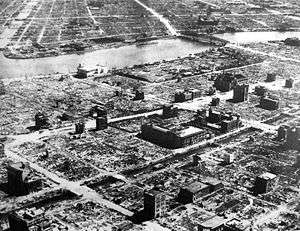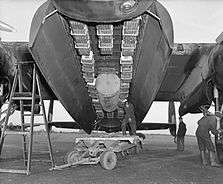Area bombardment


In military aviation, area bombardment (or area bombing) is a type of aerial bombardment that targeted indiscriminately at a large area, such as a city block or an entire city.[1] The term "area bombing" came into prominence during World War II.[1] The British Royal Air Force began area bombing at Monchengladbach on 11 May 1940.[2]
Area bombing is a form of strategic bombing.[1] It can serve several intertwined purposes: to disrupt the production of military materiel, to disrupt lines of communications, to divert the enemy's industrial and military resources from the primary battlefield to air defence, and to demoralise the enemy's population (See terror bombing).[1]
Other terms for area bombing are "carpet bombing",[3] "saturation bombing", and "obliteration bombing". At the time, area bombing was contrasted with precision bombing. The latter was directed at a selected target – not necessarily a small, and not necessarily a tactical target, as it could be an airfield or a factory – and it did not intend to inflict a widespread damage (at least by appearance).
See also
- Aerial bombardment and international law
- Aerial bombing of cities
- Civilian casualties of strategic bombing
- Firestorm
- High-level bombing
- Precision-guided munition
- Tactical bombing
References
- 1 2 3 4 5 6 Primoratz, edited by Igor (2010). Terror from the sky : the bombing of German cities in World War II (1. publ. ed.). New York: Berghahn Books. pp. 7, 21–22, 45–53. ISBN 1-84545-687-4.
- ↑ http://www.telegraph.co.uk/history/world-war-two/11410633/Dresden-was-a-civilian-town-with-no-military-significance.-Why-did-we-burn-its-people.html
- ↑ An early example of this use of "carpet bombing" is from 1942: Seemann, Berthold, ed. (1942). "The Journal of botany, British and foreign". The Journal of botany, British and foreign. R. Hardwicke. 80: 80.